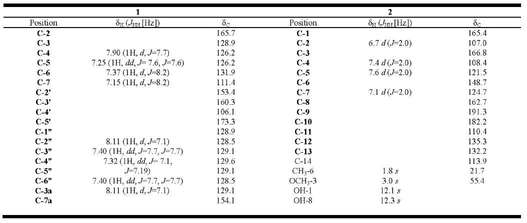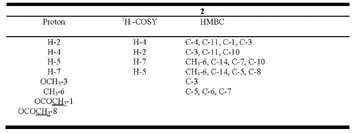Revista Boliviana de Química
versión On-line ISSN 0250-5460
Rev. Bol. Quim v.29 n.1 La Paz 2012
ARTÍCULO ORIGINAL
CALYCIN AND PHYSCION FROM THE LICHEN CANDELARIA CONCOLOR
Juan Salinas, Patricia Mollinedo, Jose Vila
1 Instituto de Investigaciones en Productos Naturales (IIPN), Carrera de Ciencias Químicas, Universidad Mayor de San Andrés, Calle Andrés Bello y Calle 27 Cota Cota, Edificio FCPN, 2° piso, La Paz- Bolivia.
Keywords: Calycin; Mannitol; Candelaria concolor; 2D-NMR; Physcion.
ABSTRACT
Calycin, Physcion and Mannitol were isolated from Candelaria concolor, lichen specie. Molecular structures, were elucidated by 2D- NMR spectroscopy techniques.
RESUMEN
Calycin, Physcion y el Manitol fueron aislados de la especie liquenica Candelaria concolor. La elucidación estructural se baso en el análisis espectroscópico de RMN-2D.
INTRODUCTION
Lichens species have a great variety of metabolic products, most of them occur naturally only in lichens and the others metabolites are also present in higher plants and fungi. Characteristics secondary metabolites of lichens species are depsides, depsidones, benzoxazine, benzofurane, usnic acid and antraquinone derivatives [1-3]. Thanks to their metabolites, lichens are widely used in perfumery and drug industry [4-5]; about sixty lichen species are present in some different types of commercial drugs, such as antimicrobial, anticancer, antiallergen, immunugical and expectoral.
The lichens are organisms that cover about 8% of the earth's surface. They often live on trees, rocks and soil. Lichens are symbiotic organisms, and members of three evolutionary lines: fungi, algae, and cyanobacteria (formerly called "blue-green algae"), but they behave as a particular organism. Lichens are commonly thought to be moss, with which they sometimes grow, and which they often resemble in size, shape, or color. The color of the lichen body, known as a thallus, is very important organ for a botanic identification. The most conspicuous species of lichens on trees tend to be gray-green or yellow-green in color, but some may be orange, bright yellow, brown, slate blue, or black. The lichens are found growing as three primary life forms: foliose, fruticose, and crustose.
The lichens are able to colonize environments that have extremes of humidity, temperature and light, and they often occur in places where few other living things are not be able to survive.
It is estimated that de Bolivian lichen flora consists of about 2500 species, now a day's approximately 150 species are known. Most of the lichen collection at National Herbarium has been collected by botanists who were mainly interested in phanerogams or other cryptogamic groups. Candelaria concolor lichen specie grows round Andean region. [6-7].
Lichen material, of Candelaria concolor, was collected from the Pongo area, 3,800 m.a.s.l. (La Paz, Bolivia). This paper describes the isolation and structure characterization of the Pulvinic acid derivative (Calycin 1), Anthraquinone derivative (Physcion 2) and the carbohydrate (Mannitol 3).
RESULTS AND DISCUSSION
The EIMS 1 showed a molecular ion at m/z 306, while the 1H NMR and 13C NMR spectra indicated that the molecular formula should be C18H10O5. The 1H NMR (CDCl3) spectrum revealed the presence of seven signals between at S 7.10 and 8.20 ppm [
8.20 ppm [ 7.15 (1H, d, J=8.2 Hz),
7.15 (1H, d, J=8.2 Hz), 7.25 (1H, dd, J= 7.6 Hz, J=7.6 Hz),
7.25 (1H, dd, J= 7.6 Hz, J=7.6 Hz), 7.32 (1H, dd, J= 7.1 Hz, J=7.1 Hz),
7.32 (1H, dd, J= 7.1 Hz, J=7.1 Hz), 7.37 (1H, d, J=8.2 Hz),
7.37 (1H, d, J=8.2 Hz), 7.40 (2H, dd, J=7.7 Hz, J=7.7 Hz),
7.40 (2H, dd, J=7.7 Hz, J=7.7 Hz), 7.90 (1H, d, J=7.7),
7.90 (1H, d, J=7.7), 8.11 (2H, d, J=7.1 Hz)] and one signal at
8.11 (2H, d, J=7.1 Hz)] and one signal at 12.95 5 for one hydroxyl proton engaged in proton bond. The 13C NMR and DEPT-135 spectra indicated the presence of eighteen carbons, nine tertiary and nine quaternary. Important HMBC correlation peaks were observed between the following protons and carbons: S 7.15 (1H, d, J=8.2 Hz) and C-3a (
12.95 5 for one hydroxyl proton engaged in proton bond. The 13C NMR and DEPT-135 spectra indicated the presence of eighteen carbons, nine tertiary and nine quaternary. Important HMBC correlation peaks were observed between the following protons and carbons: S 7.15 (1H, d, J=8.2 Hz) and C-3a ( 121.9), C-5 (
121.9), C-5 ( 126.2) and C-7a (
126.2) and C-7a ( 154.1);
154.1); 7.25 (1H, dd, J= 7.6 Hz, J=7.6 Hz) and C-7 (
7.25 (1H, dd, J= 7.6 Hz, J=7.6 Hz) and C-7 ( 111.6) and C-3a <
111.6) and C-3a < 121.9);
121.9); 7.37 (1H, d, J=8.2 Hz) and C-4 (
7.37 (1H, d, J=8.2 Hz) and C-4 ( 126.2) and C-7a à 154.1);
126.2) and C-7a à 154.1); 7.90 (1H, d, J=7.7) and C-6 (
7.90 (1H, d, J=7.7) and C-6 ( 131.9), C-
131.9), C- 7a (
7a ( 154.1) and C-3 (
154.1) and C-3 ( 128.9);
128.9); 8.11 (2H, d, J=7.1 Hz) and C-4" (
8.11 (2H, d, J=7.1 Hz) and C-4" ( 129.6), C-4' (
129.6), C-4' ( 106.1), C-5"/C-3" (
106.1), C-5"/C-3" ( 129.1) and C-2"/C-6" (
129.1) and C-2"/C-6" ( 128.5);
128.5); 7.32 (1H, dd, J= 7.1 Hz, J=7.1 Hz) and C-2"/C-6" (
7.32 (1H, dd, J= 7.1 Hz, J=7.1 Hz) and C-2"/C-6" ( 128.5) and between
128.5) and between 7.40 (2H, dd, J=7.7 Hz, J=7.7 Hz) and C-4" (
7.40 (2H, dd, J=7.7 Hz, J=7.7 Hz) and C-4" ( 129.6) and C-3"/C-5" (
129.6) and C-3"/C-5" ( 129.1). The structure was established to be calycin, the assignment of the 13C to compound 1 (Table 1).
129.1). The structure was established to be calycin, the assignment of the 13C to compound 1 (Table 1).
1,8-dihydroxy-3-methoxy-6-methylanthraquinone (Physcion) 2 was obtained as orange crystals. The molecular formula C16H12O5 was deduced from IEMS and NMR data. The 1H NMR (C6D6) spectrum revealed the presence of two methyl groups at 1.8 5 and
1.8 5 and 3.0 5. The 1H NMR spectrum also indicated the presence of four aromatic proton at
3.0 5. The 1H NMR spectrum also indicated the presence of four aromatic proton at 7.5 (H-4, d, J=2.2 Hz),
7.5 (H-4, d, J=2.2 Hz), 6.5 (H-2, d, J=2.2 Hz),
6.5 (H-2, d, J=2.2 Hz), 6.8 (H-5, d, J=2.2 Hz),
6.8 (H-5, d, J=2.2 Hz), 7.6 (H-7, d, J=2.2 Hz), and two signals at
7.6 (H-7, d, J=2.2 Hz), and two signals at 12.4 5 and
12.4 5 and 12.3 5 for two hydroxyl protons engaged in proton bonds. In the 13C NMR spectrum, the presence of two carbonyls groups at
12.3 5 for two hydroxyl protons engaged in proton bonds. In the 13C NMR spectrum, the presence of two carbonyls groups at 191.3 suggested an anthraquinone. The 2D experiments, COSY, HMQC and HMBC, complete the elucidation of the structure 1,8-dihydroxy-3-methoxy-6-methylanthraquinone (Table 2 and 3).
191.3 suggested an anthraquinone. The 2D experiments, COSY, HMQC and HMBC, complete the elucidation of the structure 1,8-dihydroxy-3-methoxy-6-methylanthraquinone (Table 2 and 3).
Mannitol 3 was obtained as white crystals, mp 188-189 oC from, a MeOH-toluene mixture. The structure was established as mannitol by comparation of melting point and NMR data reported in the literature [8].
Tables 1 and 2. 1H NMR and 13C NMR 5hift value5 for Calycin 1 (CDCl) and Phy5cion 2 (CDCl)


Table 3. 1H -COSY and HMBC data of 2

EXPERIMENTAL
General
The mass spectra were recorded with a Jeol SX 102 spectrometer, H NMR (300 MHz), on a Bruker DRX 300 MHz instrument. Column chromatography was run on Merk silica gel 60 and TLC was carried out on Silica gel GF254.
Plant Material
The lichen Candelaria Concolor were collected from Pongo-La Paz Bolivia at 3800 m.a.s.l. in June 2010.
Extraction and Isolation
Candelaria concolor grow over rocks. The lichen material was dried and powdered 2.5 g and were extracted with acetone. The solution was concentrated and the residue (0.5 g) was subjected to CC on silica gel (G-250 mesh) eluted with hexane-CHCl3-MeOH mixtures of increasing polarity. Three compounds were obtained, 0.20 g of physcion (2), 0.16 g of calycin (1) and 0.10 g of mannitol (3).
ACKNOWLEDGEMENTS
The authors would like to express their gratitude to the Swedish International Development Cooperation Agency (Sida) and IDH-2010 for supporting this work.
Notes
*Corresponding author: joselu62@hotmail.com
REFERENCES
1. Y. Asahina and S. Shibata, Chemistry of Lichen Substances, Asher, A, Co. Ltd. Vaals-Amsterdam, 1971. [ Links ]
2. C. F. Culberson, Chemical and Botanical Guide to Lichen Products, The University of North Carolina Press, Chabel Hill, 1969. [ Links ]
3. C. F. Culberson and J. A. Elix, Lichen Substances: Methods in Plant Biochemistry (P. M. Dey and J. B. Harborne, eds.), vol. 1, Academic Press, London, 1989. [ Links ]
4. T. H. Moxham, The Commercial Exploitation of Lichens for Perfume Industry, in Progress in Essential Oil Research (W. D. Gruyter, ed.), Berlin, 1986. [ Links ]
5. F. Speta, Flechten als Nutzpflanzen, Flechten bedrohte Wunder der Natur (W. Seipel, ed.), 1975. [ Links ]
6. Tassilo Feuerer, Teuvo Ahti, Orvo Vitikainen, Lichenology in Latin America, p. 71-86 CETESB Sao Paulo-1998 [ Links ]
7. Feuerer, T., Checklist of lichens and lichenicolous fungi of Bolivia version 1 March 2001. [ Links ]
8. S. Huneck and I. Yoshimura, Identification of lichen Substances, p. 134, Springer-Verlag Berlin Heidelberg 1996 [ Links ]












 uBio
uBio 

